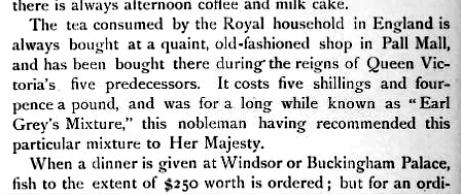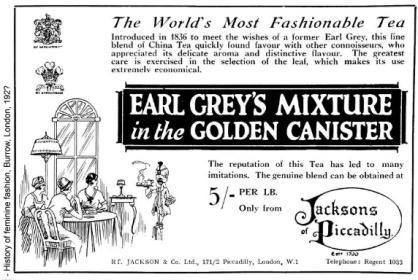

|
 Tea, most usually Indian-style black tea, but occasionally other types, flavoured with bergamot. Usually drunk with little or no milk.  Citrus bergamia, the Bergamot Orange from Köhler's Medicinal Plants, 1897 The Earl Grey in question is usually assumed to be Charles Grey, the 2nd Earl, the 1830's Prime Minister whose Reform Act greatly widened the voting franchise and who succeed in breaking the East India Company's monopoly on tea imports, thus reducing the price and making tea popular. But it seems very unlikely that the tea originated with him, and perfectly unclear how his name came to be attached to it. In a 1994 interview for 'The Daily Telegraph' the then Earl Grey is reported to have said that; "The story I tell is this: during his period as Prime Minister, the first Earl Grey sent an envoy to China, who supposedly saved the life of a mandarin's son. In gratitude, the mandarin shipped a special blend of tea, plus the recipe to make it. Earl Grey must have taken the tea and purported recipe to his tea merchant and asked him to copy it" ... "Unfortunately", he added, "we don't know who the first Earl Grey's tea merchant was and we don't know what the original blend tasted like." But is this story plausible? Apart from a confusion between the 1st and 2nd Earls Grey, China was completely diplomatically isolated in the 1830's and bergamot as an added flavouring is unknown there. So where did bergamot tea originate? One of the most highly prized of Chinese teas is the Fo Shou, a green tea from Yongchun in Fujian Province. It is said to have a taste reminiscent of the bergamot orange used in perfumery, and is sometimes called 'bergamot tea', though it does not contain any sort of added flavouring. Other teas, such as the black Keemun (or Qimen) present a similar natural flavour. It appears to have been the case that some English tea dealers took to adding bergamot flavouring to fairly ordinary tea in order to increase its value; "To render Tea at 5s. a Pound equal to Tea at 12s. - The cheapest and most expensive teas are all the leaves of the same tree, at least they should be so. The high flavour, therefore, of some of the sorts of tea and the want of flavour in others, must arise from the manner of preparing them, and must, consequently be in some measure artificial. It follows if we can discover any fine flavoured substance and add it to the tea in a proper manner, we shall be able to improve low-priced and flavourless tea into a high-priced article of fine flavour. The flavouring substance found to agree best with the original flavour of tea is the oil of bergamot, by the proper management of which you may produce from the cheapest teas the finest flavoured Bloom, Hyson, Gunpowder and Cowslip. ... When it is thus improved, it is often sold at 18s and a guinea a pound. Cowslip tea has been as high as 32s." ... which was fine, if you were open about what you were doing. Otherwise, you could get caught out, as when Brocksop & Co. found themselves in court in May 1837 accused of supplying what was said to be 'Howqua' black tea which had been "artificially scented, and appeared to have been drugged with bergamot in this country". Precisely when it was that adding bergamot to tea became respectable is not clear, nor how the "Earl" name came to be associated with it. The UK Tea Council (tea.co.uk) neatly describe it as a 'grey' area. It may be that the name originates from a tea dealer called Grey, the 'Earl' bit being added by later copyists to both differentiate their version, and make it seem posher. The likely candidate is William Grey & Co, whose 'Grey's Tea' was very widely advertised from at least 1852, sometimes with the rhyme; If your pockets and palates you both want to please, ... and Grey's 'Red Canister Tea Warehouse' at Morpeth was only a few miles from the family seat of the Earls Grey at Howick.  Morpeth Herald, Saturday 16 April 1864 Shortly after this, Grey's of Morpeth seem to disappear from the record, and 'The Celebrated Grey Mixture' Tea then turns up in advertisements for the London blenders Charlton & Co...  'John Bull', Saturday, September 7, 1867 ... who, by the 1880's, are offering a tea with the same 'The Celebrated...' slogan, but now with the 'Earl' attached, and with Charlton's claiming to be the "introducers and sole proprietors" of this, "the celebrated tea, Earl Grey's Mixture." This is the first-known usage of the name.  'Morning Post', Thursday 19 June 1884 Earl Grey acquired a royal tinge after a mention in the book 'Revelation of High Life Within Royal Palaces', supposedly by the 'Marquise de Fontenoy', but very likely a fiction by the novelist Marguerite Cunliffe-Owen, published in the USA around 1891, but widely quoted-from elsewhere...  From 'Revelation of High Life Within Royal Palaces' (1892?) It is only from the early 20th Century, and not before, that the London tea merchants Twinings in The Strand and Jackson's of Piccadilly have both claimed the product as their own. It is Twinings who have obtained the endorsement of Richard, the sixth Earl Grey, (b.1939), whose signature appears on their packages. We have never found any evidence that either company was connected with the origin of the Earl Grey brand or blend, but would welcome further information. Twinings also offer a tea variety branded as 'Lady Grey' made with lemon and Seville orange in addition to bergamot. There are dozens of other variants, including lavender, green and floral. Earl Grey seems to be a favourite drink of fictional heroes, including Jean-Luc Picard of Star Trek, Batman, Artemis Fowl, Piglet, Sir Leigh Teabing from the Da Vinci Code and Ducky Mallard of NCIS.  From 'History of Feminine Fashion' Burrow, London, c1925?  The Times, Mar 28, 1919; p4  |
|
MORE FROM Foods of England... Cookbooks ● Diary ● Index ● Magic Menu ● Random ● Really English? ● Timeline ● Donate ● English Service ● Food Map of England ● Lost Foods ● Accompaniments ● Biscuits ● Breads ● Cakes and Scones ● Cheeses ● Classic Meals ● Curry Dishes ● Dairy ● Drinks ● Egg Dishes ● Fish ● Fruit ● Fruits & Vegetables ● Game & Offal ● Meat & Meat Dishes ● Pastries and Pies ● Pot Meals ● Poultry ● Preserves & Jams ● Puddings & Sweets ● Sauces and Spicery ● Sausages ● Scones ● Soups ● Sweets and Toffee ● About ... ● Bookshop ● Email: editor@foodsofengland.co.uk COPYRIGHT and ALL RIGHTS RESERVED: © Glyn Hughes 2022 BUILT WITH WHIMBERRY |